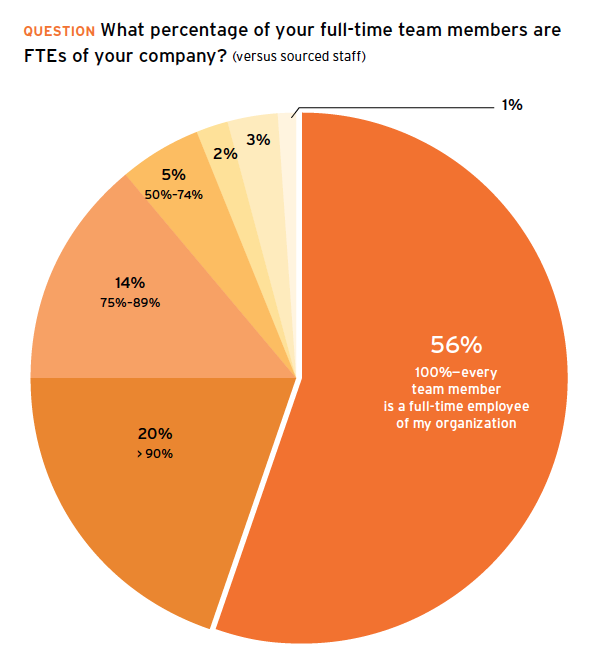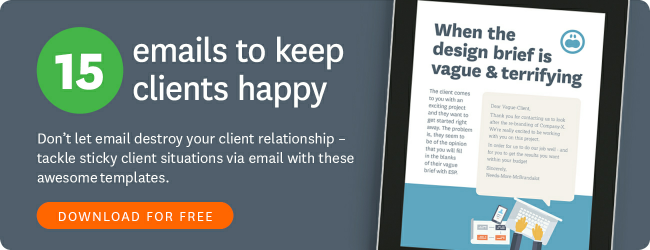Like any deadline-driven industry, agencies have a real feast-or-famine workflow. Sometimes there's two weeks of work to be done by 5pm, while other times, you can hear crickets chirping through the office. Solving the problem of an ever-changing workload is one of the challenges of creative leaders. font-size: 14px; font-weight: normal;">
But, as you'll see below, a surprising number of agencies are using a flexible staffing model to manage their workflow. Flexible staffing allows for full-time staff to find a better work/life balance by telecommuting, working different hours, and working less overtime. Contractors and temporary workers can be called in during times of peak demand. Let's have a look at how flexible staffing works and how you can apply this model to your own company:
Flexible Staffing – the Numbers
Every year, the BOSS Group, Cella and InSource put together a survey to benchmark the creative industry. The In-House Creative Services report offers valuable insight and direction for creative leaders. 425 leaders from in-house creative departments answered the survey in January 2013.
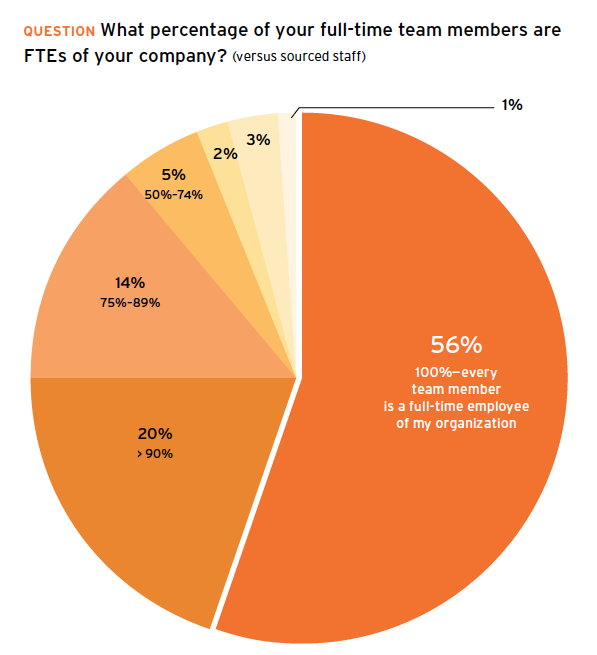 Image courtesy of The In-House Creative Services report.
Image courtesy of The In-House Creative Services report.
- One of the things this year's report highlighted was that a flexible staffing model that included contingent workers (freelancers, contractors and temps) was an important feature of many In-house creative teams. 20% of all survey respondents said 10% of their team was made up of sourced staff, and 14% are 25%-11% sourced staff. While 56% of all teams are still fully staffed by FTEs of the organization, 90% of teams reported they were able to take on temporary staff during peak demand periods.
- 30% of creative leaders with a budget to employ freelancers indicated they'd be increasing spending in the new year. 13% will be decreasing spending in this area, and 57% will be maintaining their current spending.
- Another trend emerging in the survey was that staff are routinely working overtime. Only 27% percent of staff were working less-than or equal to 40 hours, with 48% of staff working between 41-45 hours per week, and 21% working 46-50 hours per week. These results are consistent with last year's survey results. Creative leaders attribute this overtime to three main factors: deadlines (37%), temporary spikes in demand (36%) and insufficient staffing (21%).
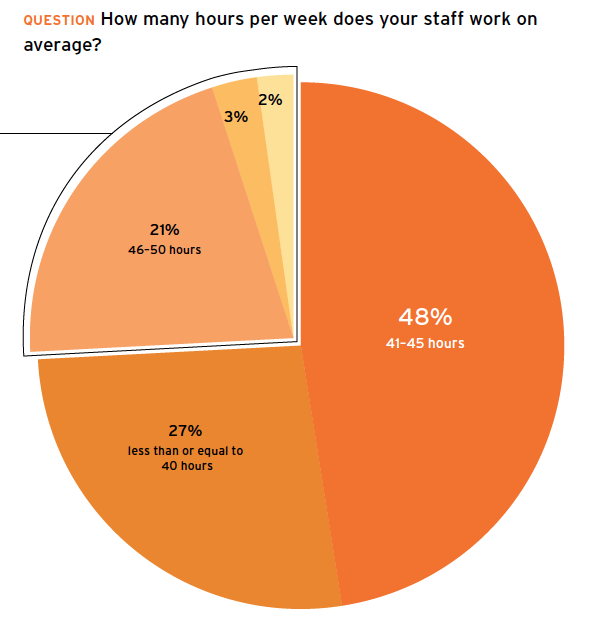 Image courtesy of The In-House Creative Services report.
Image courtesy of The In-House Creative Services report.
What All This Means
Okay, so what does all this mean to you -- the agency executive or an agency employee.
1. Agencies are cautious to grow staff numbers
First of all, in creative teams, the core staff remain FTE. Although the broader economy seems to be improving, the majority of agencies have not increased their staff from last year. There is immense pressure on the creative leaders from the management to make sure staff increases are appropriate and justifiable from a ROI perspective.
Having said that, nearly all teams have the budget and resources to take on freelancers, and nearly half of all companies surveyed are employing sourced staff in some capacity, with the majority planning for this expense to continue or increase.
Thanks to the macroeconomic trends of crowdsourcing, working from home and flexible scheduling – agencies are able to tap into this pool of highly experienced professionals available on demand across the globe, as and when required. Not only does this allow the agency executive to have the flexibility they really need for finding the right equilibrium in their staffing strategy, it also presents other benefits: cost savings and creative infusion from new team members.
2. If you love your 9-5 routine, you probably shouldn't be in the creative industry
Overtime seems to be part of the deal when working as a FTE at a creative agency. With the fast-moving landscape of marketing & advertising, agencies have never been busier. Because technology moves so fast now, clients depend on their agency partners to guide them through the ever-changing marketing landscape. Deadlines loom and demands increase. Hence, the agency staff are usually overworked. Since insufficient staffing is labeled as a factor in this, it seems some agencies at least are attempting to manage staffing shortages through flexible workers.
As cloud-based technology gets more and more sophisticated, and concepts such as crowdsourcing become more commonly used in the creative workplace, it becomes less important for a creative team to need to be in the same room together. As more agencies move their accounting and workflow management systems on to the cloud, they are beginning to utilize the different functions of these systems – which are designed with flexible teams in mind.
What are the Benefits of Flexible Staffing?
Image Courtesy Central Desktop.
Being able to bring in a range of experiences and backgrounds from all over the world is increasingly seen as an asset – not a disadvantage. So what are the benefits of flexible staffing?
- Flexible staffing provides better work/life balance: It can be hard to juggle a full-time job with other commitments. Flexible staffing policies allow your staff to explore other options that may fit around their lives better, such as telecommuting, going freelance or working outside the 9-5 day.
- Flexible staffing saves money. By employing staff only over periods of increased demand, and getting rid of them when you no longer need them, you've created an efficient staffing system that involves no extraneous employees. Having staff telecommute and work freelance can also money on office space and equipment.
- Flexible staffing enable rapid growth. If you're experiencing a growth period, then flexible staff can help you continue to meet your deadlines while focusing on expansion.
- Flexible staffing improves quality. By bringing in new creative ideas and ways of doing things through temporary staff and contractors, you're constantly invigorating your creative team, leading to more innovative and fresh concepts.
How to Structure Your Flexible Staffing

How do you utilize flexible staffing opportunities to make the most of the resources you have? Well, first let's look at the different flexible staffing options:
Flexible employees
Who are they?
Many companies are allowing employees flexibility outside the traditional 9-5 workday. Employees may come to work early and leave early, telecommute from home or other locations, or work longer hours four days a week so they can have one day off.
How do they fit?
The core of your team should be your FTE staff, and your first focus for structuring should be ensuring their needs are met. If any of these staff have a flexible work situation, you'll need to sit down and figure out how to manage this. Have staff work out a schedule together that works best for everyone (so that all three people in your team don't have a day off on the same day, etc), and that there is at least one day a week when everyone is working, so that team meetings can take place.
Freelancers
Who are they?
Freelancers work on a contract basis. An agency might take on a freelancer for a project when they require additional expertise – for example, a freelance video producer to produce a video for a website project.
How do they fit?
Adding freelancers to the mix is the best way of filling gaps in your team's expertise. Keep at team of freelancers on file – people you've worked with before who you know are trustworthy and produce on deadline. You can also call a creative staffing agency to give you freelance recommendations if required. You can hire freelancers by the project, or pay them hourly to work for you.
Interns
Who are they?
Usually university students wanting experience in the industry. Interns are usually unpaid and stay at your company for 2-4 months. During that time they want to learn as much as they can about daily life in an agency. Interns can be valuable assets as they are keen to prove their worth (and offer a ready source of new staff or freelancers), but they require an investment of staff time to train and monitor.
How do they fit?
Interns will be treated like a member of staff for the time they're in your office. They are eager to prove themselves and can be a great asset, but they also need ongoing training to ensure they get the most out of their internship. Interns will perform any task but they will prefer to be thrust into the midst of creative projects.
Permalancers
Who are they?
a recently coined term, permalancing refer to freelancers providing ongoing services to an agency – so much so that they become an integral part of the agency team, despite not appearing as part of the FTE headcount.
How do they fit?
If you're taking on a permalancer, get him or her into the office to meet the team and see how you all work together. Permalancers need more robust reporting systems and access to the same resources as your staff, and they may need training in some of the systems you use.
Temps
Who are they?
Temporary workers are called in (often through a staffing agency) to handle additional tasks during periods of peak demand. Usually, temps are employed to perform essential but non-specialized tasks, such as filing, packaging, production or customer service, leaving your team free to do the work they do best.
How do they fit?
Temps can be a great way to increase outputs during busy periods. Temp contracts are usually a standard contract given out by the agency. Because temps are often very transient and you'll normally have different temp staff on each project, you need to carefully consider the types of work you employ temps for. Most temps are hired for basic production, customer service and administration tasks, leaving your creative team free to focus on ideas and innovation.
How to Manage Projects with Flexible Staff

So with staff in different locations, working at different times on different devices, how do you keep projects in order and ensure everyone is working when and how they should be?
Here's where cloud-based technology comes into it's own. Cloud has not only enabled a flexible workplace, but it provides the tools that a flexible workplace needs to function. The most important aspect of managing a flexible workplace is to have a robust workflow management system. This is what WorkflowMax is designed for. Here's how WorkflowMax can help a creative agency manage a team working varying hours in different locations:
- Timesheets: employees can complete their own timesheets online, and hours are collated against the job, so you can see exactly who worked on what, and when.
- Job tracking and management: Everyone can see the details and progress on a job, and you can separate a project into tasks, allocate those tasks and give each one a deadline.
- Quotes and invoices: You can send professional looking branded quotes and invoices with the click of a button.
- Collaboration: Coordinate partners in a project from anywhere in the world, store email correspondence related to a job, and enable clients to review progress and leave notes.
- Reporting: Obtain valuable statistics about jobs, profit, customers and staff.
- Time Tracking: Enable staff to track the amount of time each project takes them. For creative teams, the WorkflowMax Adobe Extension allows time tracking to happen from within the Creative Suite itself.
The other important aspect of managing your flexible team is keeping everyone motivated and on-task. This can be a real challenge when team members are spread out geographically and don’t have regular contact with each other. We'll deal with this issue in the next section.
How to Inspire and Motivate your Flexible Team
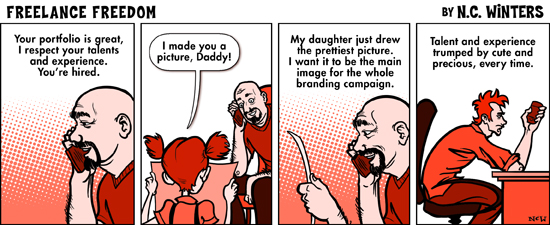
Image courtesy of Freelance Switch.
It's the nature of a flexible office that in-house staff often receive the most praise for work well done, and most of the benefits – it's hard to join in free pizza Fridays if you're a freelancer in another country, for example. The job of the creative director is to keep the whole team working together – here are some tips to make inspiring and motivating a flexible team easier:
- Take the time to get to know team members well, even if they work remotely.
- Use Skype for communication instead of email – to maintain a personal contact.
- Invite remote workers to functions at the office. Even if they can't attend, it's nice to be invited.
- Take advantage of contractors and permalancers in different locations by getting them to attend industry events in their local area.
- Get your team invested in the results. Share goals and results with them and get them to help you brainstorm ways to meet the targets.
- If possible, enable off-site and remote team members to partake in training opportunities.
How to Attract Flexible Staff
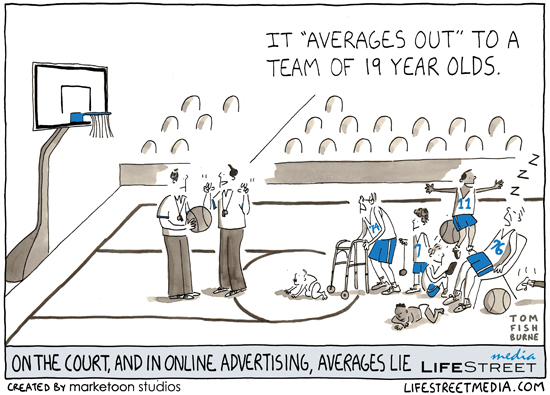
Image courtesy of Tom Fishburne.
So if you've decided that a more flexible staffing program could be beneficial for your agency, the next thing you need to do is find a way to attract potential creatives who are looking for a more flexible way of working. These days, they shouldn't be too hard to find – what creative person DOESN'T want a job that works around their life?
Here are 5 tips for finding and hiring flexible staff, and retaining them once you've found them.
- Explain the flexible benefits upfront on your career page. Many people are looking for more flexible workplaces and will immediately put your company on the top of their list.
- Approach staffing agencies about your needs. They can provide pre-screened freelancers and temps matched to your needs, often on very short notice.
- Make sure you have a chat to your HR department about what you can and can't do regarding different employment situations.
- Be upfront about your expectations. Many freelancers aren't used to checking in with clients on a regular basis, for instance, so make sure you're clear from the beginning what your expectations are to avoid confusion later on in the project.
- Ask your network for referrals for freelancers, staffing agencies and talented people you might be able to approach. If someone you trust recommends a talent, you know they're worth your while to contact.
What's the Future of Staff Flexibility in Creative Teams?
So what picture does the results of the survey – and the direction technology is heading – paint about the future of staff flexibility? Although it's impossible to predict the future, we can definitely make a few assumptions based on current data.
- As cloud technology grows and becomes more mainstream, flexible staff and schedules will become more common. The leaders in this movement toward increasing work flexibility are in the creative sector, which is always one of the first industries to experiment with new workplace concepts. The tools and technology are there to make truly flexible workplaces function, and this will only improve in the future, meaning that greater productivity and cost-savings can be achieved through flexible staffing.
- The core of a creative team's staff will continued to be employed full time, although they may telecommute or work on a schedule outside the 9-5. Freelancers and temporary workers will be called in to lend specialist skills or to help deal with peak demand.
- Companies who are not utilizing flexible staff options such as hiring freelancers and temps are getting full-time staff to do overtime on a regular basis. Overtime is one solution to overcome the feast-or-famine nature of the creative industry workflow, but it is not the only solution - and often not the best solution for staff happiness and stress levels.
- Overtime may become less acceptable as more workplaces employ flexible staffing to better manage workflow. This could lead to a more positive impact on staff morale, and better work-life balance for all concerned.
- And lastly, the breadth of experience brought into the creative team from having staff based in a variety of locales and working at different times will give agencies with flexible staffing the upper hand in creativity and innovation. An agency with flexible staffing will be more likely to embrace new technologies and ways of doing things – such as using crowdsourcing for projects.
Flexible staffing is definitely a trend in the creative sector. It can be used to expand and contract a creative team as space, circumstances and workload allow, and is a great tool for cash-strapped creative directors to effectively grow their agencies. Have you considered a flexible staffing model in your business? How can you use flexible staffing to improve your workflow, and your bottom line?




